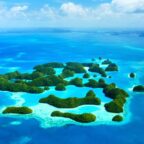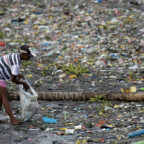
The hard coral off the shores of southern New England isn’t nearly as glamorous as its tropical counterparts — in fact, it’s barely noticed even by experienced divers — but it could play a vital role in determining the size and depth of the world’s plastic footprint.
“Coral can’t run, so it makes for a good model to see how much plastic is in a particular habitat,” said Randi Rotjan, a research assistant and professor of biology at Boston University. “My guess is that coral takes in a lot of plastic because it can’t run away from it.”
ecoRI News recently met up with Rotjan, Boston University research technician Cara Johnson and Michael Lombardi of Middletown-based Ocean Opportunity Inc. at Fort Wetherill State Park during a dive to place a substrate to collect northern star coral larvae. The substrate will be collected in six weeks and brought back to Rotjan’s laboratory to be studied.
Rotjan, in partnership with Koty Sharp from Roger Williams University, Juanita Urban-Rich from the University of Massachusetts Boston, Carolina Bastidas from MIT Sea Grant and Sean Grace from Southern Connecticut State University, are studying northern star coral — the only hard coral in New England waters — to determine the extent and impact of microplastics in an urban marine environment.
Basically, the team is studying the impact microplastics are having on northern star coral along the urban coast of New England. Plastic pollution is already a known problem. For instance, at least two-thirds of the world’s fish stocks are suffering from plastic ingestion, according to estimates, as much of the planet’s plastic pollution eventually makes its way into the ocean.
Rotjan’s project stems from concern about the 6,350 to 245,000 million metric tons of plastic in the world’s oceans, and the 4.8 to 12.7 million metric tons of new plastic that enter the ocean annually. Rotjan noted, however, that laboratory tests have concluded that urban coastal coral responds to microplastics differently than ocean coral, because of myriad reasons including sewage treatment.
Preliminary results have found 100 microplastic particles, such as microbeads used in toothpaste and facial scrubs, in northern star coral polyps, according to Rotjan.
“Microplastics come from water bottles, bags, polar fleeces,” Rotjan said. “People are shedding microplastics constantly.”
The grant-funded research project titled “Hidden Problems in Secret Corals: Exploring Microplastic Abundance in Local, Temperate Corals Along an Urban Gradient” hopes to answer the questions of whether there is a greater prevalence of microfibers in urban areas and determine the impact of sewage treatment on coral’s microplastic ingestion.
“We want to find out if this coral is ingesting the plastic or spitting it out,” Rotjan said. “Either way, though, the bacteria is likely staying behind.”
Corals are basically a natural jumble of animals with stony skeletons and a plant-like hunger for sun-soaked energy derived from symbiotic photosynthesizing algae living inside them. Coral reefs, such as the world-famous Greater Barrier Reef in Australia, are home to about 25 percent of marine species, and that is just the beginning of their environmental and economic importance. Coral reefs, for instance, shelter built-up coastlines against severe weather.
Coral reefs worldwide, however, are dying. Pollution, development, warming and acidifying oceans, and harmful fishing practices, such as dynamiting and bleaching them to capture fish for aquariums, have conspired to threaten 75 percent of reefs worldwide.
Since northern star is a temperate coral that survives the temperature shifts from summer to winter, it could also potentially provide insight into climate-change resiliency for tropical coral species. Roger Williams University’s Sharp has been researching this issue for several years.
Rotjan noted that northern star coral has the potential to transform the understanding of symbiosis — a biological partnership that is vital in tropical corals but is only sometimes used by northern star. The continued research of this coral could play an important role in better understanding the functions of coral-reef biology and how corals can tolerate a changing climate, she said.
Northern star coral, like its reef-building counterparts in the Caribbean, likes warmer waters, but it also thrives in the colder depths off Rhode Island and the rest of southern New England. Northern star is also able to survive with only small amounts of algae, because this coral species derives less than half of its energy from photosynthesis. It feeds largely on plankton snared with tentacles.
However, unlike its tropical counterparts, which can grow to the size of a car, northern star coral only grows to the size of a fist, which is rare.















Social Profiles